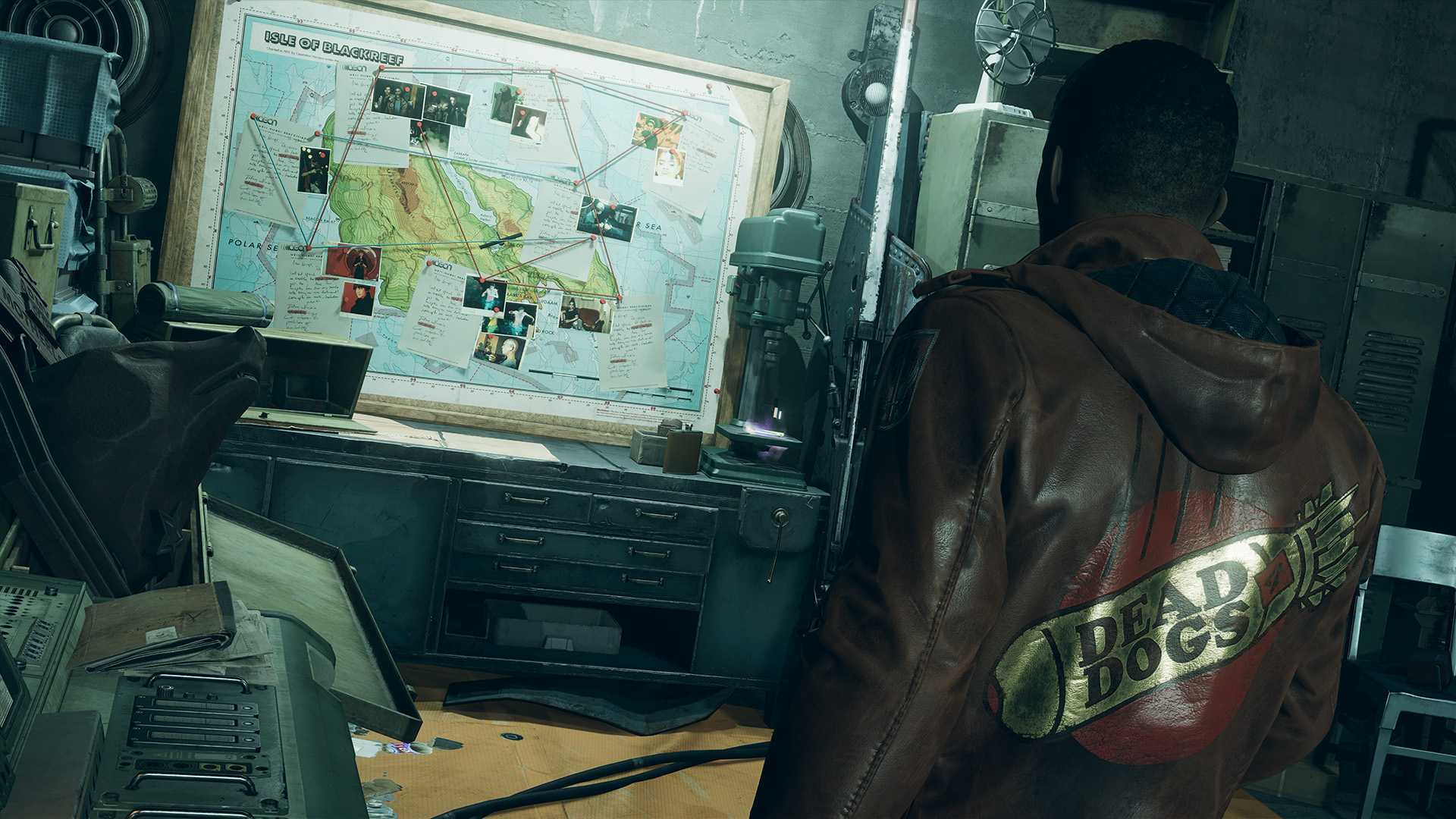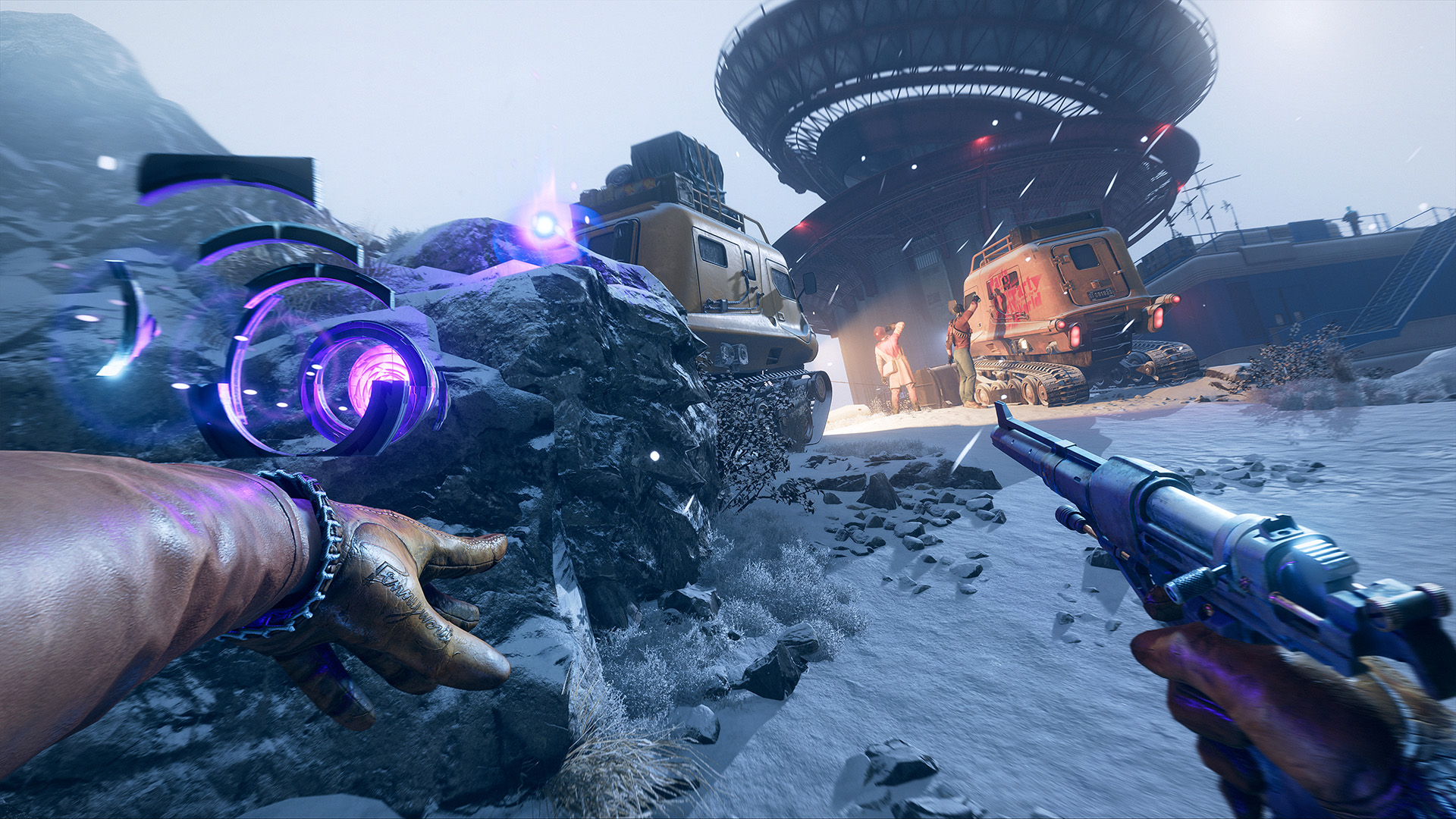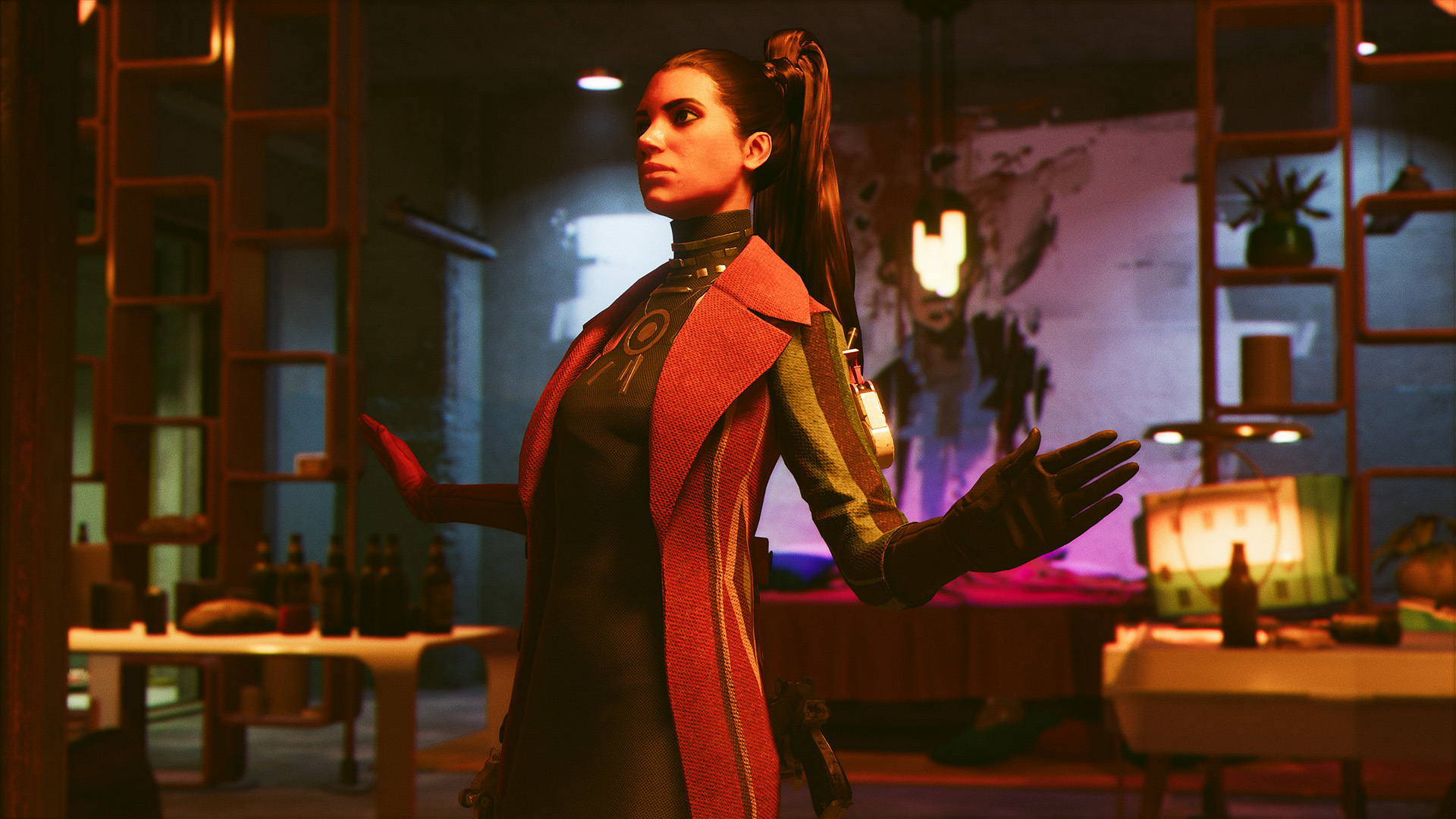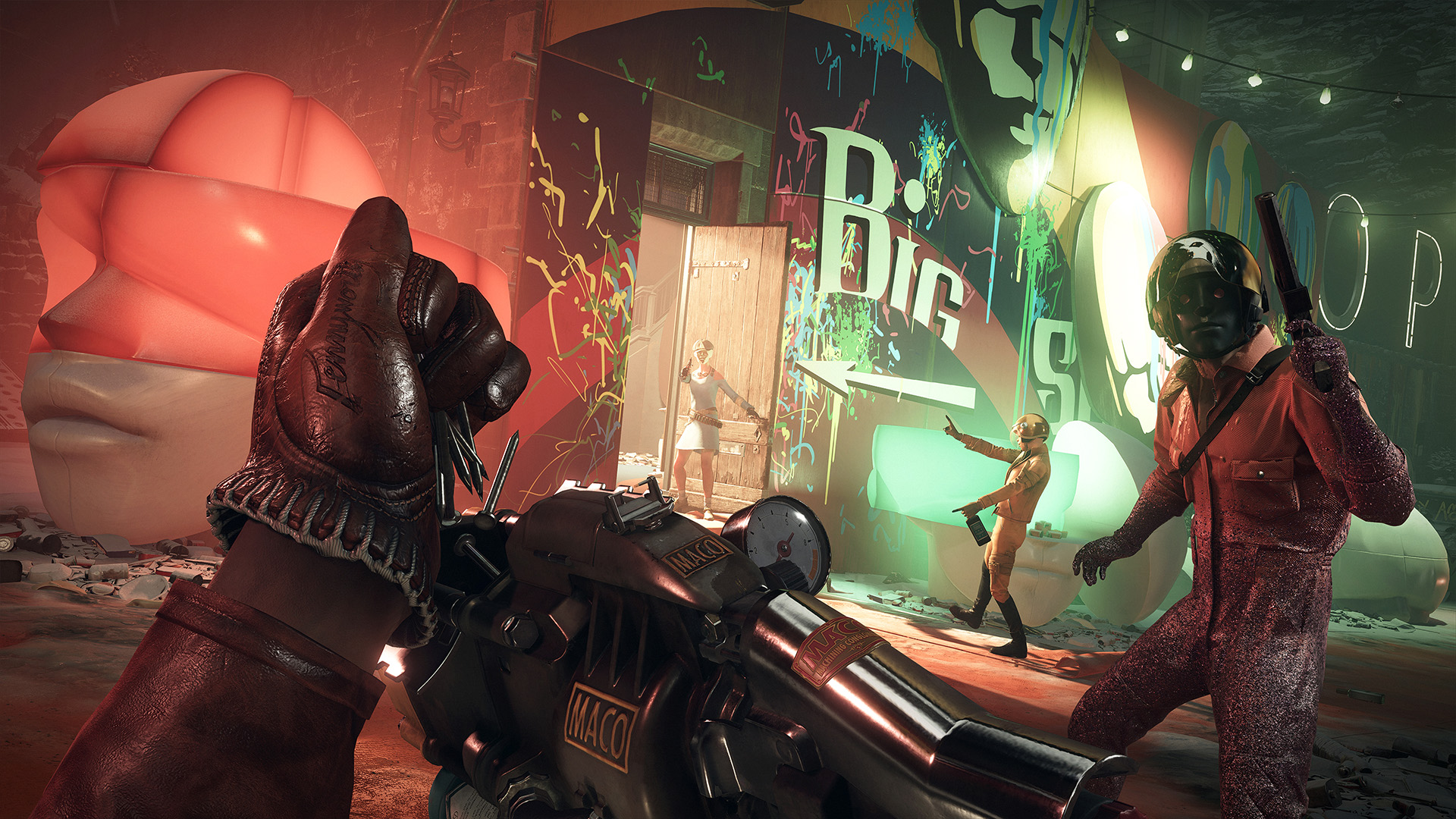Oh boy.
Deathloop has already cemented itself as one of my favorite games of the past few years. But before I tell you why it’s great, I have to tell you what it is. Thus the “Oh boy.”
Arkane Studios’ latest is, to put it mildly, a complicated game to explain. It’s a first-person stealth-action narrative shooter with roguelike elements, I guess, but that doesn’t sound quite right. It’s Dishonored with guns, kind of. Majora’s Mask meets Dark Souls, also with guns?
Every traditional, cliched approach to summing it up in a nutshell fails me. This game is unnutshellable. There’s a reason every trailer feels like three minutes of desperately explanatory narration over slick graphics and gameplay footage. Please try to understand this so you will buy it.
So what follows is a high-level overview of what Deathloop actually is. I promise you, it’s as short as I can make it.
You’re Colt. You’re trapped on the island of Blackreef, where the same day repeats itself over and over on an infinite loop, whether you live or die. Your goal is to break that loop, and the only way to do so is by killing the eight Visionaries—the people who built the loop so they could live out an endless party—in a single day.
The island is broken into four districts, and the day is broken up into four time periods: morning, noon, afternoon, and evening. The maps for the districts vary a bit based on time of day: different enemies, different secrets to discover, different areas you can access. Essentially, accounting for all the variations, there are 14 different maps you can enter (two of the districts are missing one time-of-day variation each.) Time won’t advance while you’re in a given area, but it will march onward as soon as you leave, so going to one map in the morning means you can’t go to another until noon at the earliest.

After an introductory section that shows you the ropes, you’re free to go to where you want, when you want, selecting from a menu. You’ll have leads, and the game will make sure you know where to go next if you just want to advance the story, but there’s a ton of freedom to explore on your own, and you won’t actually piece together all the clues you need unless you do so.
When you die or reach midnight, the loop resets, and all you can take with you into the next day is the information you’ve gained: new leads, keypad codes, and so on. You’ll lose everything you’ve collected, including guns, character- and weapon-improving Trinkets, and even Slabs, which grant Dishonored-style abilities.
Early on, you’ll permanently unlock a Slab that offers Colt two extra lives to give you a bit of breathing room, and eventually, you will unlock a way to hold onto some of your gear. At that point, the focus splits in two. You’re trying to make Colt stronger and max out a loadout to suit your playstyle, and you’re tracking down new clues.
Oh, and another hiccup: One of the Visionaries, Julianna, is the only person besides Colt who remembers the events of previous loops—in fact, she remembers even more of them than Colt does. She’s determined to stop Colt from breaking the loop. In addition to taunting you over the radio, Julianna can appear in your game whenever you’re in a district at the same time as another Visionary. You’ll get a warning when she shows up, but what you won’t know until one of you is dead is whether she’s controlled by AI or another player invading your world.
Whew. Like I said: complicated.
In spite of the fact that the game has a, let’s see, 500-word premise, Deathloop isn’t actually daunting to play. While the early going can be a bit tutorial-screen-heavy, once you’re up and running, the action takes center stage, and progressing through loop after loop is both seamless and thrilling. If anything, you may find the main path through the game a bit too streamlined. There’s not much room to be lost at any given moment.
Blackreef itself is a stunning creation, as full of character as Dishonored’s Dunwall but, to my tastes, far more appealing. By mixing a variety of influences from both within and outside of gaming, Arkane has crafted a world that’s constantly surprising to explore and a blast to play around in. The meticulously curated 1960s visual style, evoking everything from Mod culture to Saul Bass to James Bond, makes for a stunning murder playground.
Deathloop‘s suite of abilities, weapons, and gadgets, though not extensive, turns each trip into a district into a fun sandbox of the sort Dishonored fans will recognize and love. Whether you prefer the stealthy approach, going in guns blazing, or a hybrid of the two, you can build out a fairly satisfying loadout to suit your needs. Since you can swap out Trinkets and weapons on the fly, you’re never locked into any one set of tactics, either. If you want to stick with what works, you can. If you want to mix it up, go for it. You’ll probably want to always equip Shift—basically Dishonored’s short-range teleport, Blink—because it’s so useful, but nothing ever feels truly mandatory.

If Arkane is on familiar footing when it comes to gameplay mechanics and worldbuilding, the studio is in somewhat less charted territory with Deathloop’s storytelling. By virtue of its open-ended structure, the game can’t really settle for a traditional linear story. But neither can it strictly follow the template of many open-world games, with one meaty main story and smaller side-mission chains you can dip in and out of.
As a result, there’s probably less “plot” in Deathloop than you might expect in a game of this size. While there are a handful of mysteries that unravel gradually and a major twist or two, Arkane mostly relies on its ancillary storytelling skills to fill your time. You’ll encounter smaller stories about the Visionaries and their backstories, and micronarratives told via environmental storytelling, notes, and voice recordings you find. In a reflection of the gameplay, you’ll need to piece some of these stories together yourself, collecting clues until you get the whole picture.
It’s not a perfect fix. The endings in particular wind up feeling a bit slight (assuming I haven’t missed out on some “true” ending). But what saves the game on this front is the strength of its characters. Colt is a compelling hero, equal parts confused and determined, grizzled and silly. Julianna makes for a great foil, and their toxic chemistry shines through even though nearly all of their interactions are over comms.
The even more pleasant surprise, however, is how fleshed out—and utterly killable—the Visionaries are. Among your targets, you’ll find: a drug-addicted, attention-seeking artist; an arrogant, half-brained game designer; and a spoiled rich kid proto-venture-capitalist whose handle on Blackreef’s comms network is literally “AlphaWolf69.”
It’s difficult to imagine a group of people more satisfying to slaughter. Heck, even the random enemies throughout the maps are given small moments here and there to remind you they’re all debauched or just plain idiotic. They’re lotus-eaters. Everyone on Blackreef signed up for the promise of hedonism with no consequences. You, as Colt, are as close as it gets to consequences.
Look, I’m all for sympathetic villains—and Deathloop does present Julianna as one, to some degree—but there’s something refreshing about killing people not because they’re Hitler-tier evil, or actively causing any permanent harm to the world, but just because they’re simply unlikeable. It’s the dark catharsis of the petty revenge fantasies we all engage in at some point. If only we could punch the guy who cuts in front of everyone at the grocery store. If only we could key that Lamborghini that parked across two spaces.

Normally, this all might feel a bit ethically icky, but the loop gives you the freedom to enjoy it. No one is dead dead; they’ll be back tomorrow, and they won’t even remember anything. The people you kill are essentially NPCs that are allowed to be NPCs in the full meaning of that term by virtue of the narrative. Technically, by trying to end the loop, you may even be saving them from their nightmarish Limbo, so maybe the ends justify the means.
Then again, who cares when the means are such a blast? While I’ve played a few time-loop games, the one thing they usually miss is the part of Groundhog Day that would actually be the most fun in real life: using your preternatural knowledge to breeze through otherwise unexpected situations. While something like The Legend of Zelda: Majora’s Mask—still an amazing game, don’t get me wrong—relies on learning routines, it’s all at a macro level, so you can plan where to go and when. But Majora’s Mask really sidelines the active fun of mastery through repetition, the moment-to-moment.
That’s what Deathloop nails, above all else. By the time you finish out the main storyline, you’ll probably have a strong feel for what enemies spawn where on what maps at what time of day, and what routes they’re walking on when you first encounter them.
Now, having beaten the game a few times, I can execute the final loop in 15 minutes (level select menus and brief loading screens included). I’m far from a speedrunner, but I can fly through each level on my preferred path, Shifting onto rooftops, headshotting everyone in my way before they even know I’m there, killing the Visionary (or Visionaries), and getting back out without stopping. I feel like Phil Connors, Nightcrawler, and John Wick, rolled into one unstoppable Angel of Death.

The joy is similar to what you might get from playing a stupidly difficult section of another game over and over again. By the time you eventually overcome the challenge, you’re in a flow state where your hands know what’s going to happen next before your brain does. In Deathloop, though, you can gain that mastery while still making actual forward progress. That’s a neat trick, one that helps make Deathloop feel like more than the sum of its many familiar parts.
Of course, I’d be remiss if I didn’t mention the one big variable that can mess up your best-laid plans: Julianna. Since she locks down the exits to a district when she arrives, forcing you to hack an antenna before you can leave, she really does serve as an effective spoiler. It’s exciting but, depending on how focused you are on making progress when she shows up, also a bit annoying. She does drop valuable loot once you best her, though, so the fight can be a kind of progress in itself.
Provided you live, that is. The AI-controlled version of Julianna isn’t much of a challenge, and there’s a setting you can toggle so you won’t ever get a human player. I’m not sure I’d recommend it, though. There’s something thrilling about being stalked by another real person, and the unpredictability keeps things from getting too stale too fast.
On the flip side, I don’t know that I love actually playing as Julianna myself, at least in the few times I’ve given it a go. In my experience, it’s much more fun to be invaded than to invade someone else’s game. Given that you have to kill Colt three times to “win” and he only has to kill you once, you’re always at a bit of a disadvantage, even with the element of surprise. And if you pull it off, you’re setting someone else’s progress back, which always feels like a bit of a dick move. I actually had more fun cheesing the system: invading fellow EGM editor Michael Goroff’s game, helping him kill enemies in makeshift co-op, and then graciously bequeathing him free upgrades upon my death.
I suspect Arkane recognized most of this. While playing as Juliana, there’s a whole challenge-based progression system that lets you unlock more powerful gear and new cosmetics (for Julianna, but also for Colt). There’s way more gamified incentive to play as her, because the game knows you’re really a supporting character for someone else’s experience. It’s mechanically bribing you for being a good sport.
But even if I won’t be whiling away my time invading other people’s games, I think I’ll be replaying Deathloop quite a bit in the days and weeks ahead. It’s not a long game, or a huge one, but it is a dense one. It’s packed with secrets scattered both geographically and temporally across its world. Nearly everything you find is an invitation to keep going, to spend more time on Blackreef. It’s ironic, perhaps, that while Colt is doing everything possible to escape, I’m doing everything in my power to stay as long as I can.
|
★★★★★
Deathloop layers a refined take on Arkane’s signature mix of ability-driven action and stealth onto a time-looping premise, and the result is one of most memorable games of recent years. While many of the pieces may be familiar, the combination is fresh and full of surprises. |
Developer Arkane Studios Publisher Bethesda Softworks ESRB M - Mature Release Date 09.14.2021 |
| Deathloop is available on PlayStation 5, PC. Primary version played was for PS5. Product was provided by Bethesda Softworks for the benefit of this coverage. EGM reviews on a scale of one to five stars. | |
